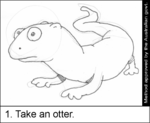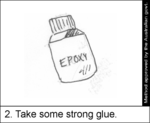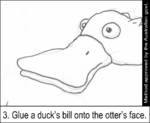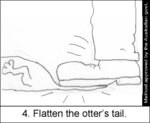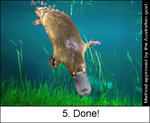HowTo:Create a platypus

|
HowTo This article is part of Uncyclopedia's HowTo series. See more HowTos |
A duck-billed platypus, that silly-looking egg-laying mammal, is actually easier to create than to define. The basic mechanism - called accelerated evolution or improved creation - can be used to make many other animals as well. For instance, the giraffe is just a stretched-out antelope.
In the case of the duck-billed platypus, the scale of components is extremely important. You cannot expect to come up with a convincing platypus if, for instance, the bill is too small for the head. You might have a hard time finding a duck with a bill large enough. In that case, catch a swan and use its bill for the purpose. You can also use glassfiber and mold the bill out of that. Remember to paint the self-made bill with polyurethane paints to reduce the effects of ultraviolet light and water. If the polyester component is in direct contact with water, it will slowly soak during time and start rotting. Ultraviolet light will start weakening the material directly. Such an inferior beak would be useless for the animal.
If you cannot fight a swan down, and if you are incompetent at molding glassfiber, you might decide to make a smaller variety of platypus. For that, you need to catch a mink. Since a duck's bill is perfectly proportioned for a mink's face, this is a viable option.
For the venom spur, you can just dip the hind legs of your creature into a can of DDT. This will have to be repeated at intervals, since the DDT will wear off during time. Depleted uranium can be used, too. It resists enviromental stress better than DDT does, is quite toxic, and helps the animal to dive. You will not need to worry over the egg-laying part: once the otter notices that the beak prevents it from catching and eating its habitual prey and forces it to eat only weeds, the resulting panic will push it into laying eggs.
Once you have glued the bill on, flattened the tail, and given the creature some venom to defend itself, the only thing left to do is to label the animal Ornithorhynchidae. After that, you can throw it into some fresh-water pool or the like.
- Warning: using a sea otter to create a fresh water platypus will land you in trouble with animal activists.
